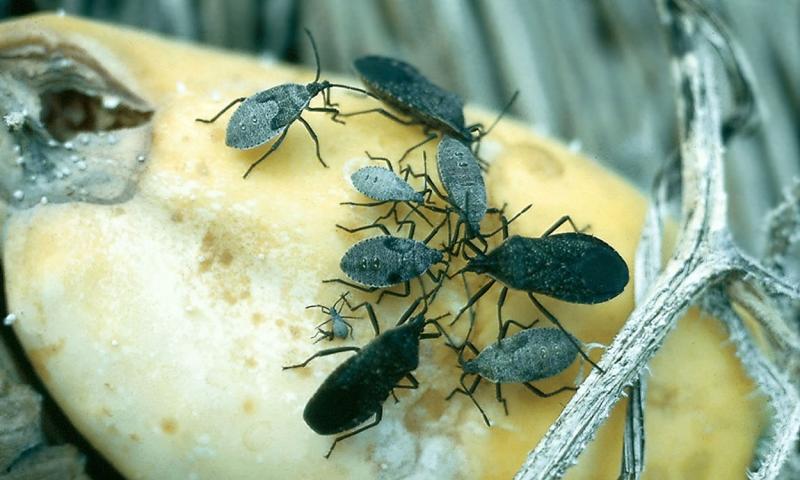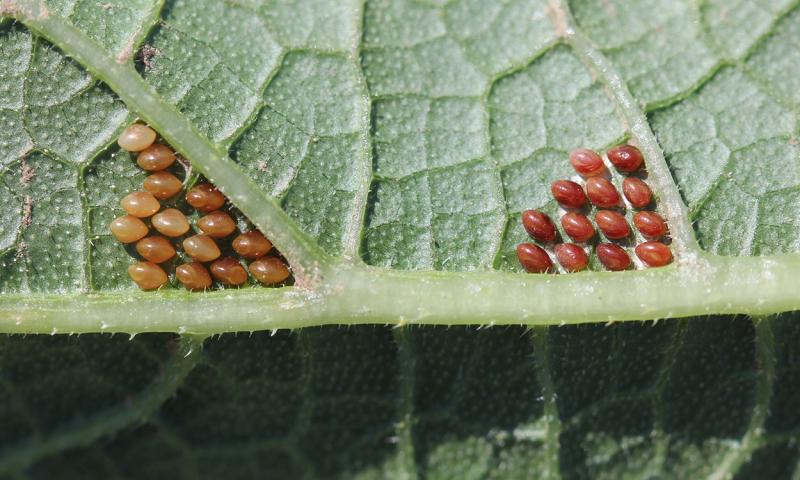
Written with contributions by Shelby Pritchard, former SDSU Extension Pest Management Specialist.
Originally Submitted: July 18, 2022
Squash bugs are one of those garden insect pests that everyone dreads finding in their garden. As their name implies, squash bugs feed on squash, along with many other cucurbits. Injury caused by extensive feeding appears as wilting and, if left unmanaged, can kill infested plants.
The nymph and adults of squash bugs are commonly found in groups on the leaves, stems and fruit of cucurbits (Figure 1). When disturbed, they produce a foul scent and scurry away quickly. Peak squash bug activity occurs in late summer and continues until the first frost. The squash bugs that are being observed right now are the overwintering population. Once they are detected in a garden, monitoring and management should continue for the rest of the growing season.
Squash Bug Biology

Squash bugs overwinter as adults and become active in the spring as temperatures warm up. Adults emerge to mate and lay eggs on the closest host plants they can find. The females lay clusters of oblong, bronze-colored eggs on the stems and undersides of the leaves between the leaf veins (Figure 2). Squash bug nymphs hatch approximately 2 weeks later and immediately begin feeding. Over the next 4 to 6 weeks, the nymphs complete their development and mature into adults. The adults continue to feed and reproduce until the first frost, when they seek shelter to overwinter. After the ovewintering population, there can be one additional full generation and possibly a partial second generation depending on the length of the growing season.
Management
Methods for preventing squash bug infestations include sanitation (cleaning up plant debris at the end of the previous season), crop rotations, trap crops (e.g. blue hubbard squash) and using physical barriers, like floating row covers, until the first female flowers bloom. Planting squash a bit later in the season allows any overwintering squash bugs to seek out and colonize other cucurbits in the area. Trap cropping a highly attractive variety, like Blue Hubbard, early in the season is a strategy to consider. Once infested, trap crops can be sprayed with an insecticide or removed from the garden and destroyed.
When plants are young, check the stems and leaves for egg clusters and crush any that are observed. This is a good preliminary strike that helps reduce squash bug populations later in the year. Regularly fertilize and water the plants to make them healthier and more tolerant to feeding injury if an outbreak does occur. This is especially important during times when plants are stressed by high heat and dry conditions.
Keep in mind that many cucurbits can handle a lot of feeding damage before fruit quality suffers. Squash bugs are adept at hiding underneath leaves, weed fabric or plastic mulch. This makes them challenging to kill with insecticides. In the case of a heavy infestation, an insecticide treatment may be necessary. Insecticides should be applied early, while squash bugs are in the nymphal stage, because the adults are much more resilient and are difficult to kill. Insecticides should be applied to the leaves (especially the underside) and at the base of infested plants. If the plants are flowering, avoid treating the flowers, as this can harm bees and other visiting pollinators.
When cleaning up your garden in the fall, make sure to remove all cucurbit debris and any weed fabric or plastic mulch that was used. Squash bugs will overwinter under those artificial soil covers and can then quickly recolonize the garden the next year.


